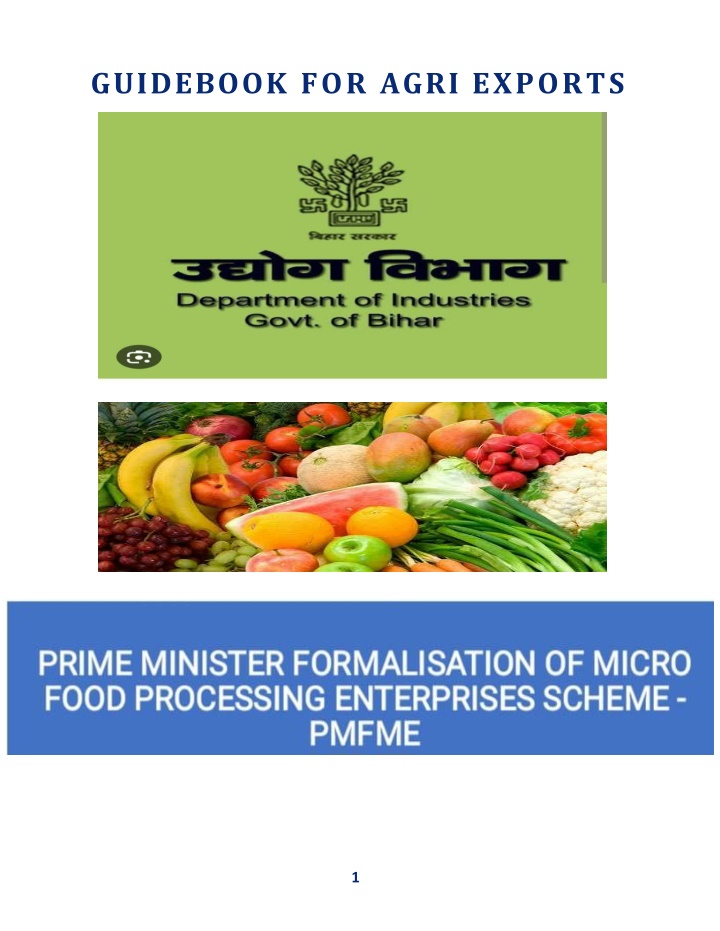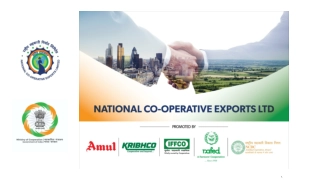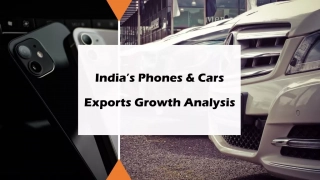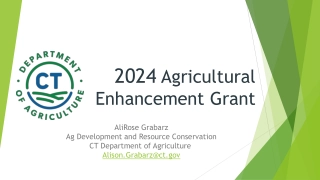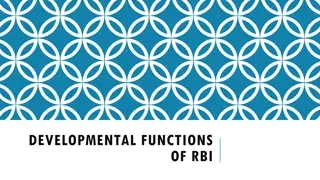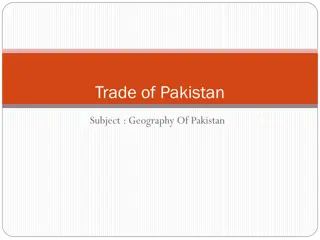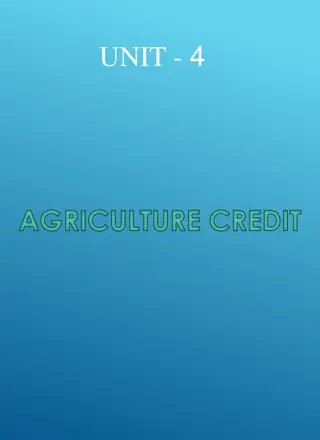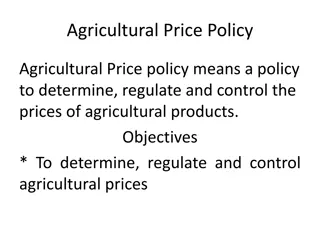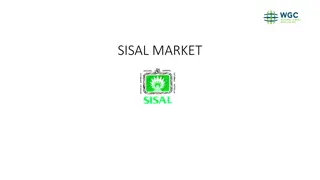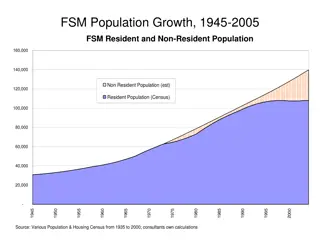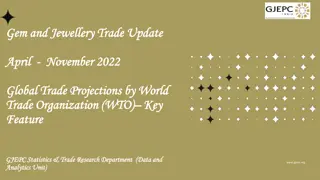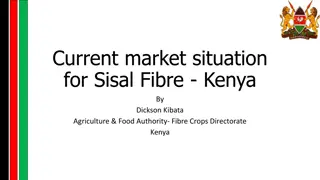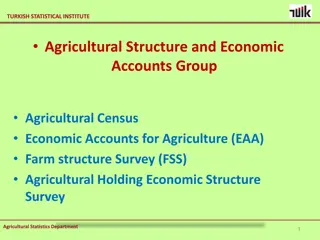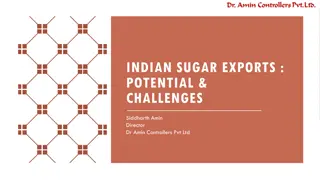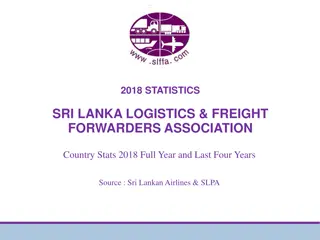Comprehensive Guide for Agricultural Exports: A Step-by-Step Manual
This comprehensive guidebook provides a detailed roadmap for entering the agricultural export business. It covers essential steps such as establishing a company, obtaining necessary certifications, selecting products and markets, finding buyers, and setting competitive pricing. The guide emphasizes the importance of thorough research and compliance with regulations to ensure a successful export venture.
Download Presentation

Please find below an Image/Link to download the presentation.
The content on the website is provided AS IS for your information and personal use only. It may not be sold, licensed, or shared on other websites without obtaining consent from the author.If you encounter any issues during the download, it is possible that the publisher has removed the file from their server.
You are allowed to download the files provided on this website for personal or commercial use, subject to the condition that they are used lawfully. All files are the property of their respective owners.
The content on the website is provided AS IS for your information and personal use only. It may not be sold, licensed, or shared on other websites without obtaining consent from the author.
E N D
Presentation Transcript
Contents 1. Adozen steps to export 4 2. Importer Exporter Code (IEC) ... 7 3. Registration- cum- Membership Certificate (RCMC) . 17 4.Phytosanitary Certificate ... 19 5. Support ... 24 Disclaimer Opinion expressed in this report are not necessarily those of the publishers and/or editors. We make every effort to verify the information, but take no responsibility for its accuracy. Sources for all data and statistics are mentioned wherever possible. Data related to schemes of various organizations have been taken from their respective websites. However, this information and schemes are subject to change from time to time, hence users may verify the same from the respective departments before use. APEDA takes no responsibility for any decisions taken by the readers or information provided herein. 2
ADozen Steps to Export Export in itself is a very wide concept and lot of preparations is required by an exporter before starting an export business. To start export business, the following steps may be followed: 1) Establishing an Organisation To start the export business, first a sole Proprietary concern/ Partnership firm/Company has to be set up as per procedure with an attractive name and logo. 2) Opening a BankAccount A current account with a Bank authorized to deal in Foreign Exchange should be opened. 3) Obtaining PermanentAccount Number (PAN) It is necessary for every exporter and importer to obtain a PAN from the Income Tax Department. (To apply https://www.onlineservices.nsdl.com/paam/endUserRegisterContact.html) PAN click here- 4) Obtaining Importer-Exporter Code (IEC) Number An IEC is a 10 digit number which is mandatory for undertaking export/ import. Application for obtaining IEC Number can be submitted to Regional authority of DGFT in formANF 2Aalong with the documents listed therein. Applicants can also apply for e-IEC on the DGFT website (http://dgft.gov.in/). Only one IEC can be obtained against a single PAN. (To apply for IEC http://dava.gov.in:8080/dgftiec/panSearch.jsp) 5) Registration cum membership certificate (RCMC) For availing authorization to import/ export or any other benefit or concession under FTP 2015-20, as also to avail the services/ guidance, exporters are required to obtain RCMC granted by the concerned Export Promotion Councils (EPC)/ FIEO/Commodity Boards/Authorities. 6) Selection of product All items are freely exportable except few items appearing in prohibited/ restricted list. After studying the trends of export of different products from India proper selection of the product(s) to be exported may be made. 3
7) Selection of Markets An overseas market should be selected after research covering market size, competition, quality requirements, payment terms etc. Exporters can also evaluate the markets based on the export benefits available for few countries under the FTP. Export promotion agencies, Indian Missions abroad, colleagues, friends, and relatives might be helpful in gathering information. 8) FindingBuyers Participation in trade fairs, buyer seller meets, exhibitions, Business to business portals, web browsing are an effective tool to find buyers. EPC s, Indian Missions abroad, overseas chambers of commerce can also be helpful. Creating multilingual Website with product catalogue, price, payment terms and other related information would also help. 9) Sampling Providing customized samples as per the demands of Foreign buyers help in getting export orders. As per FTP 2015-2020, exports of bonafide trade and technical samples of freely exportable items shall be allowed without any limit. 10) Pricing/Costing Product pricing is crucial in getting buyers attention and promoting sales in view of international competition. The price should be worked out taking into consideration all expenses from sampling to realization of export proceeds on the basis of terms of sale i.e. Free on Board (FOB), Cost, Insurance & Freight (CIF), Cost & Freight(C&F), etc. Goal of establishing export costing should be to sell maximum quantity at competitive price with maximum profit margin. Preparing an export costing sheet for every export product is advisable. 11) Negotiation with Buyers After determining the buyer s interest in the product, future prospects and continuity in business, demand for giving reasonable allowance/discount in price may be considered. 12) Covering Risks through ECGC International trade involves payment risks due to buyer/ Country insolvency. These risks can be covered by an appropriate Policy from Export Credit Guarantee Corporation Ltd (ECGC). Where the buyer is placing order without making advance payment or opening letter of Credit, it is advisable to procure credit limit on the foreign buyer from ECGC to protect against risk of non- payment.(To know more about ECGC click here- https://www.ecgc.in/) 4
Flowchart OrganizationEstablishment BankAccountOpening ObtainingPAN ObtainingIEC Number Obtaining RCMC Selectionofproduct SelectionofMarkets FindingBuyers Sampling Pricing/Costing Negotiation with buyers CoveringRisks through ECGC 5
Importer Exporter Code (IEC) How to apply: Step 1: Go to the Government website of DGFT (Directorate General of Foreign Trade) i.e. www.dgft.gov.in Now, when the DGFT main page opens, click on the Importer Exporter Code (IEC) option available in the Quick links section on the left hand side of the page. 6
Step 2: Once you click on the option Importer Exporter Code (IEC) select the option, Online IEC Application Step 3: A new page will open which will be entitled as Login for IEC online . Now in the PAN option, please enter the PAN Card Number of the Proprietor or of Entity in case of an Entity firm. Once you have entered the PAN Card number, select the NEXT option. Now enter your Mobile Number (without a zero or a country code) and Email ID .Enter the given Captcha code as it is in the empty box given right below the captcha and click on the Generate Token option. 7
Step 4: Now you will receive a token number on the mobile number and email ID which you have entered above. After receipt of token numbers, enter the same in each of the respective boxes provided separately, one for the Mobile Token and another for the Email Token and click on the Submit option. Step 5: Update Master Data Now a new page shows an E-com Number on the left hand side of the page. This number will be used for all the future references regarding your IEC application. Once you receive this page click on Update Master Data . will open, entitled as Importer Exporter Code (e-IEC) which 8
Now a new green coloured pane will open on the right side of the same page in which you need to fill all the basic information of the entity i.e. Name, Address, City, State, District, PIN Code. The mobile number, email ID and PAN card number will be pre fed. Enter the Name as given on the PAN Card and Date of Incorporation of the same. Now enter the Name of concern (Proprietorship/Company). Enter the Preferred Activity (you can select one of the given options for the preferred activity). Now enter the Bank A/c Number , A/c Holder s Name , Bank Name and the Bank Branch . Also enter the IFSC Code of the Bank. Also fill in the Name of the Applicant , Designation , Official Address , Applicant s Mobile Number , Email ID , Declaration Date and Declaration Place . Once all the details are filled correctly, please click on Update . (Personal), PAN Number Step 6: Add Branch Details After that click on the second option, Branch on the left hand side of the same page. Branch details of the proprietorship/ company shall be filled. Once you fill all the relevant details click on ADD . If there is no Branch Office Keep the space empty. Now again go to the left hand side of the same page and click on the third option, Director . Now fill all the required details of any of the Director/ Proprietor/ Partner/ Karta/ Managing Trustee. All the required information for example, the PAN number, mobile number should belong to the person of whose details you are filling. Once all the relevant options are being filled please click on ADD . 9
Step 7: Attach Scan Copies of Required Documents Now click on the sixth option, Attachments on the left hand side of the same page. In the newly opened pane at the right hand side, you need to upload the documents i.e., PAN Card (of proprietor in case of proprietorship firm and of company in case of Private Limited), a Cancelled Cheque and a Photograph. Now to upload the documents select the documents category and documents type. (PAN Card and Cancelled Cheque should be in PDF format and the Photograph should be in GIF format). Note: Leave the option, Signed Copy of the Application . Then click on Choose File and choose the selected files on your computer and click on Upload . Step 8: Pay Application Fees 10
After all these details are filled in, please click on the fourth option, Application Fee on the left hand side of the same page. Then the blue screen entitled Payment Initiation Screen will open. as Fill up all the relevant details in the empty boxes on this blue screen and enter amount Rs. 500/- as the Government IEC application fee. Also you need to fill all your required bank details for a successful online bank payment. Then click on Submit. Note: all the * marked options shall be mandatorily filled in by the applicant. Once the online payment is successful, again the previous page will re-open. After all the above steps are done, you need to select the ninth option, Checklist on the left hand side of the same page. In checklist, please make sure that all the conditions mentioned here have been complied with. For example, please make sure whether the details of the applicant filled in the application form are as same as that in the uploaded copy of the documents provided by him. Once you click on the option yes on all the check list points please click on Print Checklist . After this is completed please click on the tenth option, Preview on the left hand side of the same page. In preview it will show you all the details filled in the application. If all the mentioned details are correct then please click on, Print Application. Once you print the application, sign the same. After that scan the signed application and once that is done go back to the Attachments option and upload the signed application in a PDF format. Step 9: Submit the Application Now when the scanned copy of the signed application is uploaded, click the twelfth option, Submit on the left hand side of same page and submit the application with Digital Signature of class-2 or class-3. 11
Note: the application cannot be submitted without Digital Signature. Step 10: Check Application Status When your application is submitted you need to click on the thirteenth option, Application Status on the left hand side of the same page to check the status of your application i.e., whether it is successfully submitted or not. We hope the IEC Code Application Procedure is now clear. 12
BENEFITS OF IEC Open International Market IEC helps you in taking your organization and products to the worldwide market and develop your organizations. You can also sell your products on international platforms Product scaling and Increased Revenue there will be a vast increase in the revenue of the organization Several benefits are availed the organization and various companies can avail several benefits from DGFT, customs, etc as per the IEC registration. On Exports the organization can claim tax benefits as well Filing of return is not required IEC does not require the recording of any profits. When allocated, there isn't any necessity to pursue any kind of procedures for supporting its legitimacy. Notwithstanding for fare exchanges, there isn't any necessity for recording any profits with DGFT Easiest procedure. It is genuinely simple to acquire IEC code from the DGFT inside a time of 10 to 15 days subsequent to presenting the application. There isn't any need to give a proof of any fare or import for getting IEC code No need of any renewal IEC code is successful for the lifetime of a substance and requires no recharging. It could also be utilized by a substance against all fare and import exchanges WHEN YOU REQUIRE IEC If an importer needs to clear his shipments from the traditions at that time IEC is required by the traditions experts When in importer sends cash to another country through banks at that point IEC is required by the bank At the point when an exporter needs to send his shipments then its required by the traditions port When an exporter receives foreign currency in his bank account, IEC is required NEEDS OF IEC Importer need IEC License for custom clearance. Exporters need IEC License for export subsidy. Bank requires IEC License for sending and receiving money to foreign customers. For Food Licensing and APEDA Licensing IE Code is required. 13
Registration-Cum-Membership Certificate (RCMC) Online Registration Procedure Step 1: Sign-up through the APEDA Website. (Click on "Register as Member" link on the Home Page) . Step 2: The exporter require to first enter the basic detail, IE CODE, Email ID & Mobile number and submit. Step 3: An OTP (One Time Password) for confirming the details will be sent on E-mail and Mobile number. Exporter should enter the OTP of mobile and E-mail on the verification screen to verify the both and click on Submit to proceed for application. Step 4: After verification confirmation, exporter will require to fill online application and upload the required documents. The documents should be in the JPEG, PDF or PNG formats only. The exporter should enter all required information carefully and ensure correct information is submitted in the online application form. Step 5: On-line application can be completed in one or more sessions by revisiting the website using the assigned OTP (One Time Password) of E-mail and Mobile. After filling the fields, the exporter can save the information in between by using the Save button. The exporter can edit the filled data until online payment is not made. Step 6: The exporter may submit registration fees of Rs. 5000/- excluding taxes = Rs. 5900/- (with GST) may be made through any of the following modes:- Online Credit Card(MasterCard and Visa) Debit Card (MasterCard and Visa) Offline Demand draft in favour of APEDA payable at respective cities of APEDA offices (Note :- APEDA GST No. 07AAAJA1150H1ZU) Step 7: After completion of Payment process an application number will be generated. Please note the application number for future reference. Step 8: On issuance of RCMC, Login detail is sent to the registered email of the exporter. The Exporter may login in to their account through Exporter Login link given at APEDAwebsite. Step 9: The exporter can view the status of the RCMC application by clicking the "Track Application" link to view the status of application by submitting the IE Code and Application number until it is issued. 14
Step 10: In case of any shortcoming is observed in the application the exporter will require to resubmit the document online. Therefore, exporter is required to monitor the status of the RCMC application as informed above at Step10. Step 11: Following documents are required with application form: 1. Self-certified copy of Import-Export code issued by D.G.F.T. 2. Bank Certificate duly signed by the authorities. 3.In case the exporter desired to register as Manufacturer Exporter, they should furnish a self attested copy of the registration of the company with the relevant certification agencies for the products given below:- Products Forticulture and seeds CertificationAgencies Dept. of Horticulture/ DIC / SIA / FSSAI Dept. of Agriculture / Horticulture / DIC / SIA / FSSAI DIC / SIA / FSSAI / Udhyog Aadhaar Memorandum issued by ministry of MSME Fruits & Vegetables Groundnut / Pulses / Guargum Processed Fruits & Vegetables / Processed Food Products / Meat Products / Cereal Preparation / Misc. preparation Dairy / Poultry / Honey Alcoholic Beverages Cereals FSSAI FSSAI / EIC / EIA Dept. of Excise Commissioner DIC / SIA / FSSAI / Udhyog Aadhaar Memorandum issued by Ministry of MSME Step 12: After the approval of RCMC from APEDA officials, exporter may take printout of their Certificate through their APEDA Login under the heading of View RCMC Certificate under RCMC Menu. 15
FOR EXPORT OF WHEAT DOCUMENTS REQUIRED DIC / SIA / FSSAI / Udhyog Aadhaar Memorandum issued by Ministry of MSME
Phytosanitary Certificate Phytosanitary certificates are issued to indicate that consignments of plants, plant products or other regulated articles meet specified phytosanitary import requirements and are in conformity with the certifying statement of the appropriate model certificate. Phytosanitary certificates should only be issued for this purpose. Model certificates provide a standard wording and format that should be followed for the preparation of official phytosanitary certificates. This is necessary to ensure the validity of the documents, that they easily recognized, and that essential information is reported. Importing countries should only require phytosanitary certificates for regulated articles. These include commodities such as plants, bulbs and tubers, or seeds for propagation, fruits and vegetables, cut flowers and branches, grain, and growing medium. Phytosanitary certificates may also be use for certain plant products that have been processed where such products, by their nature or that of their processing, have a potential for introducing regulated pests (e.g. wood, cotton). A phytosanitary certificate may also be required for other regulated articles where Phytosanitary measures are technically justified (e.g. empty containers, vehicles, and organisms). Explanatory notes and requirements for filling up the application form: 1. Applicant's particulars: It is for identification of the person who is the consignor or who acts on behalf of a named company that provide the information in this application. The applicant is responsible for all the legal and financial liabilities in related to all the information declared in the application. The name and address of the applicant should be in Singapore. 2. Name and address of exporter (consignor): This information identifies the source of the consignment to facilitate and audit by AVA. The name and address should be located in Singapore. However if the local agent or shipper is acting on behalf of an international company with a foreign address, both the name of local agent/ shipper and the international company with the foreign address should be declared here. 3. Name and address of consignee: The name and address should be inserted here and should be in sufficient details to enable the National Plant Protection Organisation (NPPO) of the importing 19
country to confirm its identity. The NPPO may require that the address be a location in the importing country Declared means Information on how the consignment is shipped. Please select one of the following terms: sea, air, road, mail or passenger. of conveyance 4. Declared name of vessel: This is an optional field and the ship s name and voyage number or the aircraft flight number should be included if known. 5. Country of destination: Select the name of importing country (final destination) for the consignment. Please contact Import and Export Regulation Department (Tel: 67519842-3) for consignment which transits through another country before reaching its final destination. 6. Declared point of entry: Please declare the name of port or city in country of final destination. Please contact Import and Export Regulation Department (Tel: 6481 3864/4854) for consignment which transits through port or city not in country of final destination. 7. Declared date of shipment: Please indicate the date of departure of the consignment/ vessel from Singapore. 8. Category of produce: Please select the types of commodity with is closest to the description of each of the export commodity listed below. 20
COMMODITY EXAMPLES DURIAN PLANTS, MANGO PLANTS ETC FRUITS PLANTS(NMB) ALL VEGETABLESSEEDS VEGETABLE SEEDS(KGM) GARLIC, GINGER, ONION, POTATO, MUSHROOM, TAPIOCA, TAMARIND, SAGO, SEA WEEDS, DRIED LILY FLOWERS, VANILA POD, NOODLES, BETELNUT, WHEAT FLOUR, TAPIOCA STARCH, FLOUR, SESAME SEEDS FOOD PRODUCE(TNE) FRUITS(KGM) DURIAN, MANGO, PAPAYA & OTHER (FRESH/DRIED) VEGETABLE(KGM) VEGETABLES, CARROT, BROCOLI 9. Name of produce/ botanical name of plants: Information provided here should be sufficiently descriptive of the commodity (which should include the commodity class, i.e. fruit, cut flower, plants for planting, etc) that can be recognized by the NPPO of the importing country. Entries should not refer to trade names, quality/ grade or other commercial purposes and terms. Botanical name of plants should be used if this is required by the NPPO of the importing country. 10.Quantity declared: Please declare the correct quantity in accordance to the unit of measurement as defined. Other quantity and unit can be declared under Name of produce/ botanical name of plants if necessary. 11.Number and description of packages: Sufficient details should be included in this section to enable the NPPO of the importing country to identify the consignment and its component parts, and verify their size if necessary. The following are some common description of packages: bales, boxes, bundles, cartons, containers, drums, pallets, etc. 21
12.Place of origin: This refers to place(s) from which a consignment gains its phytosanitary status, i.e. where it was possibly exposed to possible infestation or contamination by pests. Normally, this will be the place where the commodity originated. For consignment or parts of consignment which is/are not of Singapore origin, a separate Phytosanitary Certificate for Re-export will be issued. 13.Foreign Phytosanitary Certificate number: Applicable only to consignment or parts of consignment which is/are declared not originating from Singapore. Please provide the original phytosanitary certificate number in this section if any and also confirmthe following: Original or certified true copy will be forwarded to NPPO of the importing country (applicable only to consignment with phytosanitary certificate; please select Original or Certified True Copy ) The consignment or parts of consignment is/are packed or repacked (please select Packed or Repacked ) in original or new containers (please select Original or New ). This section is mandatory for all consignments not originating fromSingapore. 14.Distinguishing marks: Please enter the distinguishing marks on bags, cartons or other containers that assist the identification of the consignment. If the consignment is without distinguishing marks, please enter NILor NotApplicable in this section. 15.Disinfestation and/or Disinfection Treatment: Treatments indicated should only be those that are acceptable to NPPO of the importing country and are performed in Singapore by AVA's accredited treatment providers or under the direct supervision of AVA. These can include fumigation, heat treatment, chemical spraying/ dipping and can include devitalization and seed treatments. 16.Additional Declaration: Additional declarations should be only those containing plant health information required by the NPPO of the importing country. It should be kept to a minimum and be concise. Examples of Additional Declaration are: phytosanitary regulation such as Pest Free Area, Free From Particular Pests and Diseases, Import Permit number or BilateralAgreements. No trade information should be declared here. 22
17. Remarks/ Special Instructions: This is an optional section. Please declare all the trade information in this section if necessary. A separate attachment to the Phytosanitary Certificate will be issued on this special request. 23
Support Schemes for Exporters PARTA: Agricultural & Processed Food Products Export Development Authority (APEDA) Schemes 1. Development of Export Infrastructure Description: Assistance is available for the establishment of the post harvest infrastructure for the fresh horticulture produce like integrated pack house, cable handling system for banana and other similar requirements for other crops, purchase of insulated, Reefer transport/mobile pre-cooling units etc. Nature of assistance: This scheme provides Integrated Pack house to improve compliance of Phyto-Sanitary requirements, purchase of insulated transport or mobile pre-cooling units are provided for cold chain strengthening and take account of the processing facilities for horticulture crops to enhance productivity, efficiency, and quality for value added products. 2. Quality Development Description: Implementation and certification of quality and Food Safety Management Systems, Standardization, harmonization, with international standards for adoption of global standards, hand held devices for capturing farm level peripheral coordinates for traceability systems. Nature of assistance: This scheme is responsible for implementation and certification of quality and Food Safety Management Systems for all APEDA scheduled products to adhere to food safety compliance, harmonization with International standards including payment of fee to International auditors. 3. Market Development Description: For evolving structured marketing strategies for export of food products, market intelligence for taking informed decisions, international exposure, skill development, capacity building and high quality packaging are some of the important aspects. These are implemented through Market Development component which involves participation in International Trade Fairs. 24
Nature of assistance: This scheme comprises of New Market/Product development through conducting feasibility studies for identification of potential product / market. It also deals with assistance for trial shipment for fresh horticulture produce and Registration of Brand/IPR outside India. Administrating ministry/ agency: Agricultural and Processed Food Products Export DevelopmentAuthority (APEDA) Whom to apply: APEDA Website: www.apeda.gov.in PART B: Other Schemes 1.Export Oriented Unit (EOU) Scheme Description: EOU environment coupled with better infrastructural facilities for export production. duty-free Scheme provides an internationally competitive Nature of assistance: The units are allowed to import or procure locally without the payment of duty all types of goods including capital goods, raw materials, components, packing materials, consumables, spares and various other specified categories of equipment. Administrating ministry/ agency: Ministry of Commerce & Industry, Government Of India Whom to apply: Department Of Commerce Website: www.commerce.gov.in 2. Market Access Initiative (MAI) Scheme Description: MAI Scheme is an Export Promotion Scheme, envisaged to act as a catalyst to promote India s exports on a sustained basis. Nature of assistance: The scheme is formulated on product focus country approach to evolve specific market and specific product. These activities are eligible for financial assistance - marketing projects abroad, capacity building, support for statutory compliances, studies, project development, etc. Administrating ministry/ agency: Ministry of Commerce & Industry, Government Of India 25
Whom to apply: Department Of Commerce Website: www.commerce.gov.in 3. Services Exports from India Scheme (SEIS) Description: The SEIS has been introduced to increase exports of notified services. Nature of assistance: The rewards under SEIS shall be admissible for exports made/services rendered on or after the date of notification of this policy. The duty credit scrips shall be granted as rewards under SEIS. The duty credit scrips and goods imported/domestically procured against them shall be freely transferable. Administrating ministry/ agency: Directorate General of Foreign Trade, Ministry Of Commerce Whom to apply: Directorate General Of Foreign Trade Website:www.dgft.gov.in 4. The Merchandise Exports from India Scheme (MEIS) Description: The MEIS has been introduced for the export of specific goods to specified markets. Nature of assistance: Rewards for the export of notified goods to notified markets under MEIS shall be payable as percentage of realised FOB value. Administrating ministry/ agency: Directorate General Of Foreign Trade, Ministry Of Commerce Whom to apply: Directorate General Of Foreign Trade Website:www.dgft.gov.in 6. Export Promotional Capital Goods (EPCG) Scheme Description: The objective of the EPCG Scheme is to facilitate import of capital goods for producing quality goods and services to enhance India s export competitiveness. Nature of assistance: EPCG Scheme allows import of capital goods for preproduction, production and post-production at zero customs duty. 26
Administrating ministry/ agency: Directorate General Of Foreign Trade, Ministry Of Commerce Whom to apply: Directorate General Of Foreign Trade Website:www.dgft.gov.in 7. Rashtriya KrishiVikas Yojana (RKVY) Description: RKVY scheme was initiated in 2007 as an umbrella scheme for ensuring holistic development of agriculture and allied sectors by allowing states to choose their own agriculture and allied sector development activities as per the district/state agriculture plan. RKVY scheme incentivizes States to increase public investment in Agriculture & allied sectors. Under RKVY, States have been provided flexibility and autonomy for selection, planning approval and execution of projects/programs under the scheme asper their need, priorities and agro-climate requirements. Administrating ministry/ agency: Ministry of Agriculture And Farmers Welfare, Government of India Whom to apply: Ministry ofAgricultureAnd Farmers Welfare Website: www.rkvy.nic.in 8. National Horticulture Mission (NHM) Description: National Horticulture Mission (NHM) is an Indian horticulture Scheme promoted by Government of India. It was launched under the 10th five-year plan in the year 2005-06.While Government of India contributes 85%, 15% share is contributed by State Governments. The NHM's key objective is to develop horticulture to the maximum potential available in the state and to augment production of all horticultural products (fruits, vegetables, flowers, coco,cashew nut,plantation crops, spices, medicinal aromatic plants) in the state. Administrating ministry/ agency: Ministry of Agriculture And Farmers Welfare, Government of India Whom to apply: Agriculture Cooperation & Farmers Welfare Website: www.hortnet.gov.in 27
9.Mission Organic Value Chain Development for North East Region (MOVCD- NER) Description: MOVCD-NER is a Central Sector Scheme, a sub-mission under National Mission for Sustainable Agriculture (NMSA), launched by the Ministry of Agriculture and Farmers Welfare for implementation in the states of Arunachal Pradesh, Assam, Manipur, Meghalaya, Mizoram, Nagaland, Sikkim and Tripura, during the 12th plan period. The scheme aims to development of certified organic production in a value chain mode to link growers with consumers and to support the development of entire value chain starting from inputs, seeds, certification, to the creation of facilities for collection, aggregation, processing, marketing and brand building initiative. scheme aims at promotion and production of certified organic commodities focusing on export oriented crops oranges of Tamenglong, lemons of Kachai (Ukhrul), pineapple, king chilli, ginger, turmeric as horti crops and chakhao (black aromatic rice) as agri crop. The Administrating ministry/ agency: Ministry of Agriculture And Farmers Welfare, Government of India Whom to apply: Agriculture Cooperation & Farmers Welfare Website: www.hortnet.gov.in 10. Mega FoodPark Description: The Scheme of Mega Food Park aims at providing a mechanism to link agricultural production to the market by bringing together farmers, processors and retailers so as to ensure maximizing value addition, minimizing wastage, increasing farmers income and creating employment opportunities particularly in rural sector. The Mega Food Park Scheme is based on Cluster approach and envisages creation of state of art support infrastructure in a well-defined agri / horticultural zone for setting up of modern food processing units in the industrial plots provided in the park with well- established supply chain. Mega food park typically consist of supply chain infrastructure including collection centers, primary processing processing centers, cold chain and around 30-35 fully developed plots for entrepreneurs to set up food processing units. centers, central Administrating Government of India ministry/ agency: Ministry of Food Processing Industries, Whom to apply: Ministry Of Food Processing Industries Website: www.mofpi.nic.in 28
11. Export Processing Zone Scheme Description: Export promotion has always been the chief concern of the government of India and it strictly follows the ISI policy while carrying out all its activities. The main reasons behind setting up the EPZ in India have been listed as under: Ensuring better infrastructural facilities in the industrial units that were set up in the export processing zones in India Introducing the privilege of tax holidays Establishing 100 percent export-oriented system in the EPZ in India EPZ in India are entirely devoid of all kinds of duties, levies, and taxes Implementing tax holidays in the importing of goods like capital goods, raw materials, and consumer goods as well. The units in export processing zones follow the automatic route set by the government of India which offers 100 percent foreign direct investment in the zone The rules set by the government of India are executed and implemented by the development commissioner of the respective export processing zones in India Administrating ministry/ agency: Ministry of Commerce & Industry, Government of India Whom to apply: Special Economic Zone of India, Government of India Website: www.sezindia.nic.in 12. Trade Infrastructure For Export Scheme (TIES ) Description: The TIES (Trade Infrastructure for Export Scheme) is a major initiative by the Ministry of Commerce, Government of India in enhancing India s export competitiveness. This paper gives a brief introduction about the scheme. It explains in detail about the discontinued Assistance to States for Development of Export Infrastructure and Allied Activities (ASIDE) scheme. It further enlists key differences between ASIDE and TIES. It further compares the trade costs of India and China with 10 countries and gives information about the latest infrastructure policy of China and its famed Open Door policy which propelled its growth rate to almost 10% every year since 1978. Administrating ministry/ agency: Ministry of Commerce & Industry, Government of India Whom to apply:Department Of Commerce Website: www. Commerce.gov.in 29
Controlling the quality and/or consistency of goods Verifying compliance with the standards of the destination country 15 What is post shipment finance? Post Shipment Finance is a kind of loan provided by a financial institution to an exporter or seller against a shipment that has already been made. This type of export finance is granted from the date of extending the credit after shipment of the goods to the realization date of the exporter proceeds. Exporters don t wait for the importer to deposit the funds. The post shipment finance can be classified as : Export Bills purchased/discounted Export Bills negotiated Advance against export bills sent on collection basis. Advance against export on consignment basis Advance against undrawn balance on exports Advance against claims of Duty Drawback. 16 What is IEC Number? IEC Stands for IMPORTER EXPORTER CODE. No export or import shall be made by any person without an Importer-Exporter Code (IEC) number unless specifically exempted. 17 What is anti dumping?What is its purpose in International Trade? Dumping is said to occur when the goods are exported by a country to another country at a price lower than its normal value. This is an unfair trade practice which can have a distortive effect on international trade. Anti dumping is a measure to rectify the situation arising out of the dumping of goods and its trade distortive effect. Thus, the purpose of anti dumping duty is to rectify the trade distortive effect of dumping and re-establish fair trade. The use of anti dumping measure as an instrument of fair competition is permitted by the WTO. In fact, anti dumping is an instrument for ensuring fair trade and is not a measure of protection per se for the domestic industry. It provides relief to the domestic industry against the injury caused by dumping. 18 What is BankGuarantee? A bank guarantee is a written contract given by a bank on the behalf of a customer. By issuing this guarantee, a bank takes responsibility for payment of 30
a sum of money in case, if it is not paid by the customer on whose behalf the guarantee has been issued. In return, a bank gets some commission for issuing the guarantee. Anyone can apply for a bank guarantee, if his or her company has obligations towards a third party for which funds need to be blocked in order to guarantee that his or her company fulfill its obligations. 19 What Is EXIM policy? Export Import Policy or better known as Exim Policy is a set of guidelines and instructions related to the import and export of goods. The Government of India notifies the Exim Policy for a period of five years (1997 2002) under Section 5 of the Foreign Trade (Development and Regulation Act), 1992. The current policy covers the period 2002 2007. The Export Import updated every year on the 31st of March and the modifications, improvements and new schemes became effective from 1st April of every year. All types of changes or modifications related to the Exim Policy is normally announced by the Union Minister of Commerce and Industry who coordinates with Ministry of Finance, the Directorate General of Foreign Trade and its network of regional offices. Policy is the 20 What is FEMA? Foreign Exchange Management Act or in short (FEMA) is an act that provides guidelines for the free flow of foreign exchange in India. It has brought a new management regime of foreign exchange consistent with the emerging frame work of the World Trade Organisation (WTO). Foreign Exchange Management Act was earlier known as FERA (Foreign Exchange Regulation Act), which has been found to be unsuccessful with the proliberalisation policies of the Government of India. 21 What is EPCG Scheme? The scheme allows import of capital goods for pre production, production and post production (including CKD/SKD thereof as well as computer software systems) at 5% Customs duty subject to an export obligation equivalent to 8 times of duty saved on capital goods imported under EPCG scheme to fulfilled over a period of 8 years reckoned from the date of issuance of license. Capital goods would be allowed at 0% duty for exports of agricultural products and their value added variants. be 31
22 What is a Certificate of Origin? A Certificate of Origin (CO) is a document which is used for certification that the products exported are wholly obtained, produced or manufactured in India. It is generally an integral part of export documents. 23Can any Chamber of Commerce and Industry/Association issue the Certificate of Origins? No. Only bodies authorized by DGFT, Union Ministry of Commerce and Industry can issue Certificate of Origin 24 What is EIC? EIC is the official certification body of the Government of India. It has been established under the Export (Quality Control and Inspection) Act, 1963 (22 of 1963), for advising the Central Government on measures to be taken for development of export trade through quality control & pre-shipment inspection. 25 What are EIAs? EIAs are the five Export Inspection Agencies having headquarters at Bombay, Calcutta, Cochin, Delhi & Madras. EIAs are autonomous bodies established by the Central Government under the Export (Quality Control and Inspection) Act, 1963 (22 of 1963), as the field organisations for implementing the policies of the Central Government with respect to quality control and / or pre shipment inspection of export commodities from India. 26 What is the basis of EIC/EIAs inspection and certification? Depending upon the product, any of the following or a combination is taken as the basis of inspection and certification Requirements laid down in the notification; Buyers Requirements; Requirements of the importing countries; National and International Standards; Contractual specifications; Primary aim of the EIC / EIAs in this respect is to ensure compliance of the product to the requirements of the importing country and / or the buyer. 32
27 What is the advantage of EIC/EIAcertification to exporters? The certification of EIC/EIAs provides the following benefits to the exporters: Independent third party certification as a tool for market access. Official assurance of quality, which is becoming particularly relevant in food sector to meet regulatory requirements of importing countries. Free entry for Indian products in overseas market through equivalence agreements / MOUs with official import control bodies of our trading partners whereby EICs certification is recognized by them as meeting their requirements. 28 What is CODEX? The Codex Alimentarius Commission was created in 1963 by FAO and WHO to develop food standards, guidelines and related texts practice under the Joint FAO/WHO Food Standards Programme. The main purposes of this Programme are protecting health of ensuring fair trade practices in the food trade, and promoting coordination of all food standards work undertaken by international governmental and non- governmental organizations. such as codes of the consumers and 29 What is the purpose of the CodexAlimentarius? Codex Alimentarius follows the principle that consumers have a right to expect their food to be safe, of good quality and regard, the safety and essential quality of internationally traded food is of paramount importance. Codex has set a number of standards and codes on foods for vulnerable groups such as infants and young children, to provide adequate nutrition while protecting them from foodborne risks and to reduce infant mortality and morbidity worldwide. suitable for consumption. In this 30 What is MRL(Maximum Residue Level)? MRLs are defined as the maximum concentration of pesticide (expressed as milligrams of residue per kilogram of food/animal feeding stuff) likely to occur in or on food and feeding stuffs after the use of pesticides according to Good Agricultural Practice (GAP), i.e. when the pesticide has been applied in line with the product label recommendations and in keeping with local environmental and other conditions). MRLs are primarily trading standards, but they also help ensure that residue levels do not pose unacceptable risks for consumers. residue 33
31 How MRLs calculated? Where there is an approved use of the compound on a particular crop, pesticide residues on imported produce ('import tolerances'), the MRL is generally set at a value determined from field trials (i.e. where the crop has been treated with the pesticide and samples of the crop have been analyzed to determine residue levels). MRLs can typically be less than a milligram (mg) of pesticide residue in a kilogram of food (1mg/kg or less than one in a million) up to 5 mg/kg. or 32 What Is CreditInsurance? Trade credit Insurance insures suppliers against the risk of non- payment of goods or services by their buyers. This may be a buyer situated in the same country as the supplier (Domestic Risk) or a buyer situated in another country (Exporter Risk). The insurance covers non- payment as a result of insolvency of the buyer or non-payment after an agreed number of months after the due date. It may also insure the risk of non-payment following an event outside the control of the buyer or seller (political risk cover), The risk that money cannot be transferred from one country to another. 33 What is GSTP(Global System of Trade Preference)? The GSTP is an Agreement on economic co - operation for promotion of trade by providing preferential trading among developing countries. The scope of GSTP has included complementary trade liberalization techniques as follow: tariff reduction removal or reduction of non-tariff and para-tariff barriers direct trade measures as well as mid-term and long-term contracts sectoral agreement 34 What is Bill of Lading? A bill of lading is a type of document that is used to acknowledge the receipt of a shipment of goods. A transportation company or carrier issues this document to a shipper. In addition to acknowledging the receipt of goods, a bill of lading indicates the particular vessel on which the goods have been placed, their intended destination, and the terms for transporting the shipment to its final destination. 34
